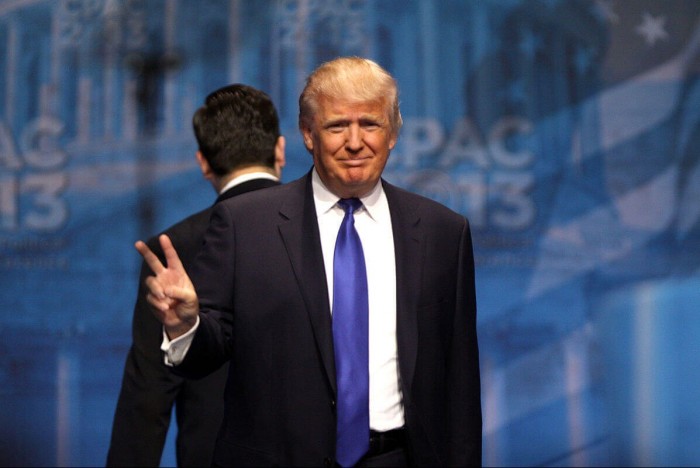A mass exodus is expected after the midterms. Leadership professor, Dimitrios Spyridonidis, highlights what lessons can be learned from the high staff turnover at the White House
Over many seasons of The Apprentice, Donald Trump honed the craft of firing people. And, if the first half of his presidency is anything to go by, it’s a skill he’s brought with him to his role as commander-in-chief.The Trump administration has had the highest staff turnover in the first year of a presidency of the last 100 years. Politico is predicting another mass exodus after the upcoming US midterm elections.
So, what kind of leadership is this? And what lessons does it hold for business school students?
An individualistic leadership style

According to Dimitrios Spyridonidis, associate professor at Warwick Business School, if we were to look at the United States as a company and Donald Trump as its CEO, the high staff turnover reveals some troubling things about his leadership model.
“I think what is really obvious here is that the leadership model that dominates everything in this case is a model that was invented 50 years ago by macho white men with a strong focus on self-interest,” Dimitrios says. “It’s all about being centre of attention.”
Dimitrios’ core expertise is in the area of leadership and innovation—a leadership style harking back to the 1960s and 70s troubles him.
“That particular model, 50 years ago, probably worked,” he says, “but now, times have changed! It’s impossible for leaders to know everything that they need to know to deal with the challenges that they face, and the fact is that the leadership challenges [nowadays] require different skills and capabilities.”
The trouble is that the model of strong leadership that Dimitrios suspects Trump is working with focuses on a single individual with absolute authority, rather than the combined efforts of a team of experts under a co-ordinating manager.
“If we do a historical analysis of the managerial ideas that were practised back in the 60s, you could be an expert because it was simply easier to read everything that there was to read,” Dimitrios explains. “Fast-forward to 2017: there’s so much written in the area of leadership and management that it is very difficult for an individual to be an expert.”
Certainly, it would take years to become well-versed in even just one of the things that now need to inform presidential decision-making—whether that’s technology, environmental change, or trade agreements with other countries.
“It’s really difficult for a leader to know everything—but I think it is possible for a team to know enough to do a world-class job,” Dimitrios says.
Loyalty vs. experience
Herein lies another issue. According to a paper by Kathryn Dunn Tenpas, a senior fellow of governance studies at the Brookings Institution in Washington DC, Donald Trump has prioritized loyalty over experience in choosing his staffers.
By giving positions of authority to those without sufficient qualifications but who helped him win the presidential election, Kathryn Tenpas argues that Donald Trump’s administration functioned chaotically in its first year, with knock-on effects for long-term staff retention rates.
This is undoubtedly a big problem for any leader. Which attribute is more valuable? Loyalty or experience?
“There’s no easy answer to such a complex situation,” Dimitrios admits. “But I think one of the key characteristics of leadership is the occasions that leaders have to balance paradoxical tensions—leaders should have the ability, but also the gut feeling, for what is the right balance.”
This has resulted in mixed results for President Trump’s advancement of new policies, and in terms of employee morale, there’s no denying that a spate of firings can pose a big problem. Dimitrios says that if they can, leaders should avoid a dramatic thinning of the ranks.
“There is a saying that you join a company, but you leave a manager,” he says sagely. “The biggest evident impact [of high staff turnover] is company disengagement, and that disengagement I feel is crucial.”
This disengagement most frequently manifests in disengagement from a company’s strategy, purpose, and vision, Dimitrios says, and with a campaign run on big-picture thinking—making America “great again”—losing grip on this key aspect can have a chaotic effect.
For instance, when veterans affairs chief David Shulkin was reportedly forced out of the administration, he took to the opinion section of the New York Times, lambasting the power struggle that he saw unfolding in the White House and the promotion of political agendas over what was best for veterans.
Ego to ecosystem
“My own personal view is that Donald Trump’s leadership style is dangerous for many reasons, primarily because it doesn’t seem to work anymore,” says Dimitrios. “It’s something that was created for white people, macho behavior, in the past, and it served a different purpose. That purpose doesn’t exist anymore.
“We used to say to our students that in the past, we had to compete with each other to create value. These days, the way that we create value is by collaborating.”
This shift—from ego to ecosystem, one charismatic leader to a team of skilled collaborators—is a response to a complex and rapidly-shifting world, one transforming not just politically, but technologically, culturally, and environmentally. Without creating a strong and well-maintained team, an organization is less likely to be able to weather the changes of today’s world.
“A good leader needs to understand that she or he is an incomplete person—and that’s not an insult!” Dimitrios advises.
“Leadership teams can be a complete team. It starts with understanding that we as individuals are incomplete, but together we are something better—and that’s one of the key points that an MBA [ or other business school student] might take from this situation.”
The main image in this article is credited to ©Gage Skidmore and used under this license.
Student Reviews
BSc Management with Marketing
I loved Warwick business school.
The staff is supportive, my academic tutor was key in my development throughout the 3 years and you have to meet with her/him every term. Most professors are helpful and would happily offer support if needed. You also have office hours and can contact professors by email and through the forum.
In general, WBS instills in you the willingness to learn and the resilience needed for you for whatever career you choose.
Very international community which broadens your horizon and makes you more open minded and self aware. You will most certainly make friends and memories for life. I recommend that you get outside of your comfort zone and try new activities with your friends!
WBS also has a great reputation and offers careers opportunities, and careers support throughout the degree.
There is the opportunity to do a year abroad to further develop on a personal level. I wasn’t able to do this due to Covid but I would have loved to do it during normal circumstances! Would definitely recommend this.
Although Warwick is not a city university, the campus vibe has a lot of advantages, especially at an undergraduate level. You are always around familiar faces, and in a student environment. Moreover, Birmingham is only 20 mins away from Leamington spa and London is only one hour away! Perfect for a day trip or a weekend getaway!
Life at Warwick Business School
Pursuing my master's degree at WBS has been a game-changer in my life. With high-quality education, interaction with students from across the world, amazing campus life and much more. I was able to learn about business, finance, project management and strategy all in one course: MSc in Management at WBS. Besides the top-notch education from the best professors, I also enjoyed being a part of fun societies and participating in fun activities such as scavenger hunts and so much more.
The school also organises many company visits and interactions which help students get a head start at finding a job. As my course came to an end, I also have a good full-time job placement in my hands.
Overall, my experience at WBS was a great one.
Outstanding
The Warwick Business School was like a dream come to life for me. The University ranking speaks for itself, from top-tier facilities to some of the best professors I had to honour to study with I fell in love with my course. Interactions with people from all over the world gave me a newfound confidence in myself.
Career prospects after graduating are endless due to the contacts of the universities and the success rate for previous students, it does open a lot of doors for students in various career fields. The campus life is quite good as well with a lot of student groups and clubs, and extra circular activities to engage students at all times. Loved my experience.
A good business school
It is a very cutting-edge, career-oriented business school, all courses are very practical, and the college does a very good job of career service. From the hardware and facilities to the staff, the student experience is at the core of the school and student satisfaction is taken very seriously. I understand that many universities in the UK are relatively traditional and can occasionally be rigid in terms of rules and regulations, and although WBS has a relatively short history, this makes it more innovative and dynamic, which is essential for a business school. The downside is that because it is on the outskirts of Coventry, it is a long bus ride to the city centre, not to mention the difference in experience from a big city like London.
Campus
The people, campus, staff. It’s a very enjoyable environment and it’s particularly good for learning and playing sports. The people there are extremely friendly and welcoming and it’s very easy to make friends
What I Like About Warwick
I’ve personally liked my experience at Warwick so far because of the amazing people I’ve gotten to meet and how many opportunities we students are provided with to learn and grow.
Within Warwick, I’m part of the Business School, a learning haven comprised of well-structured modules and extremely helpful people
All in all, a great place to be :)
Campus Life
One thing that stood out for me was the campus life, you felt like part of a community. The social aspects of the student union and on-campus accommodation meant you can easily get together and enjoy with friends. Additionally, I felt the course provided a variety of subjects allowing me to enhance my knowledge, from Marketing to Law and Finance. Overall I would most definitely recommend this university to friends and family.
Excellence self catered
The campus is very welcoming and Modern. There are many opportunities at Warwick but it is up to the student how do they want to make the most out of it and the staff at the school will definitely helo as much as possible. The location and the ranking have been amazing.
Warwick business school
Warwick business school is one of the best universities around the globe with a solid base of economic and business studies. Moreover, students get a chance to study in a diverse and warm environment with professional stuff which tries to provide the best opportunities for career development. One of the memorable features of the university are great events which sometimes take a place in one of the landmarks of the London city, the Shard building.
BSc Management with Marketing
I loved Warwick business school.
The staff is supportive, my academic tutor was key in my development throughout the 3 years and you have to meet with her/him every term. Most professors are helpful and would happily offer support if needed. You also have office hours and can contact professors by email and through the forum.
In general, WBS instills in you the willingness to learn and the resilience needed for you for whatever career you choose.
Very international community which broadens your horizon and makes you more open minded and self aware. You will most certainly make friends and memories for life. I recommend that you get outside of your comfort zone and try new activities with your friends!
WBS also has a great reputation and offers careers opportunities, and careers support throughout the degree.
There is the opportunity to do a year abroad to further develop on a personal level. I wasn’t able to do this due to Covid but I would have loved to do it during normal circumstances! Would definitely recommend this.
Although Warwick is not a city university, the campus vibe has a lot of advantages, especially at an undergraduate level. You are always around familiar faces, and in a student environment. Moreover, Birmingham is only 20 mins away from Leamington spa and London is only one hour away! Perfect for a day trip or a weekend getaway!
Life at Warwick Business School
Pursuing my master's degree at WBS has been a game-changer in my life. With high-quality education, interaction with students from across the world, amazing campus life and much more. I was able to learn about business, finance, project management and strategy all in one course: MSc in Management at WBS. Besides the top-notch education from the best professors, I also enjoyed being a part of fun societies and participating in fun activities such as scavenger hunts and so much more.
The school also organises many company visits and interactions which help students get a head start at finding a job. As my course came to an end, I also have a good full-time job placement in my hands.
Overall, my experience at WBS was a great one.
Outstanding
The Warwick Business School was like a dream come to life for me. The University ranking speaks for itself, from top-tier facilities to some of the best professors I had to honour to study with I fell in love with my course. Interactions with people from all over the world gave me a newfound confidence in myself.
Career prospects after graduating are endless due to the contacts of the universities and the success rate for previous students, it does open a lot of doors for students in various career fields. The campus life is quite good as well with a lot of student groups and clubs, and extra circular activities to engage students at all times. Loved my experience.
A good business school
It is a very cutting-edge, career-oriented business school, all courses are very practical, and the college does a very good job of career service. From the hardware and facilities to the staff, the student experience is at the core of the school and student satisfaction is taken very seriously. I understand that many universities in the UK are relatively traditional and can occasionally be rigid in terms of rules and regulations, and although WBS has a relatively short history, this makes it more innovative and dynamic, which is essential for a business school. The downside is that because it is on the outskirts of Coventry, it is a long bus ride to the city centre, not to mention the difference in experience from a big city like London.
Campus
The people, campus, staff. It’s a very enjoyable environment and it’s particularly good for learning and playing sports. The people there are extremely friendly and welcoming and it’s very easy to make friends
What I Like About Warwick
I’ve personally liked my experience at Warwick so far because of the amazing people I’ve gotten to meet and how many opportunities we students are provided with to learn and grow.
Within Warwick, I’m part of the Business School, a learning haven comprised of well-structured modules and extremely helpful people
All in all, a great place to be :)
Campus Life
One thing that stood out for me was the campus life, you felt like part of a community. The social aspects of the student union and on-campus accommodation meant you can easily get together and enjoy with friends. Additionally, I felt the course provided a variety of subjects allowing me to enhance my knowledge, from Marketing to Law and Finance. Overall I would most definitely recommend this university to friends and family.
Excellence self catered
The campus is very welcoming and Modern. There are many opportunities at Warwick but it is up to the student how do they want to make the most out of it and the staff at the school will definitely helo as much as possible. The location and the ranking have been amazing.
Warwick business school
Warwick business school is one of the best universities around the globe with a solid base of economic and business studies. Moreover, students get a chance to study in a diverse and warm environment with professional stuff which tries to provide the best opportunities for career development. One of the memorable features of the university are great events which sometimes take a place in one of the landmarks of the London city, the Shard building.









